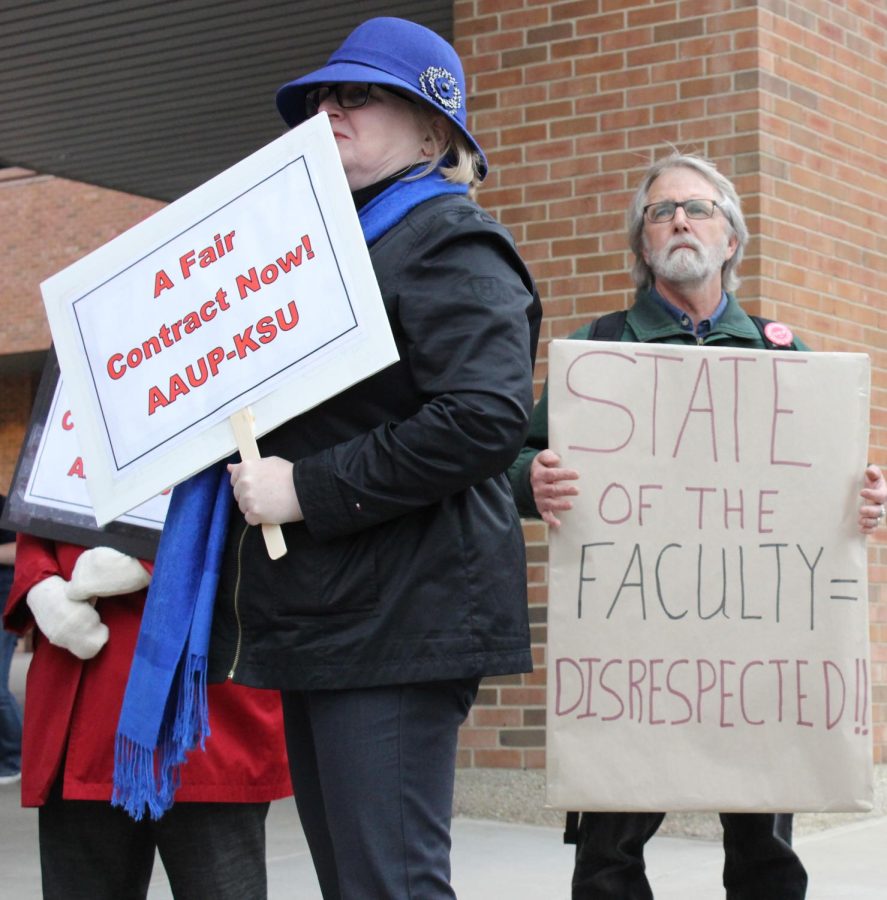What you need to know about a potential professors’ strike
November 22, 2015
Last Thursday, members of the tenured faculty picketed outside the KIVA during president Beverly Warren’s State of the University Address. Multiple signs read, “A Fair Contract Now!” and “Value the Faculty.” The Stater reported in September that negotiations between the university and the Kent State chapter of the professors’ union, the American Association of University Professors, reached an impasse. Now, members are taking an online vote to potentially authorize a strike.
So, what’s going on? The Stater provides an explanation of the common terms used and parties involved, and what could happen if the two sides do not reach an agreement.
What is a union?
A labor union or academic union, often shortened to just union, is an organization made up of employees with similar, vested interests that works as a single unit to get the most beneficial environment for all members. According to Investopedia.com, unions are industry-specific, but represent the collective interests of a group to determine wages, and working conditions and hours, among other things.
What do unions do?
According to the AAUP Collective Bargaining Congress, unions provide members (in this case, the professors at Kent State) with information and resources they otherwise might not receive from their employer. This includes information about legal rights, workplace benefits and collective bargaining influence.
What is collective bargaining?
Collective bargaining is “the process in which working people, through their unions, negotiate contracts with their employers to determine their terms of employment,” according to the American Federation of Labor and Congress of Industrial Organizations, or AFL-CIO, the largest trade union in the U.S.
So what is a bargaining unit?
A bargaining unit is the group of people represented by the union that an employer recognizes; the group within the union that deals directly with an employer or employer’s representative in order to negotiate agreements or contracts.
What is a collective bargaining agreement?
A CBA is accord between the union and the employer. It is negotiated, meaning both sides have a voice in what the contract says, and it sets terms of employment for members of the union. The agreement is a contract that includes wages, hours, vacation and sick days and benefits. The current three-year agreement expired on Aug. 23, 2015.
Who is involved in the process?
Representatives from both the university and the union meet to discuss the contract. In September, when the two sides failed to reach an agreement, an impasse was reached. On Oct. 13, federal mediation was requested. If mediation does not resolve the issues raised because of the impasse, then a “fact-finding” process will begin.
What is “fact-finding?”
This is the process in which a neutral, third-party would propose an agreement. According to an article on Cleveland.com, this agreement would need to be approved by the union’s members and the university’s Board of Trustees.
What is the difference between tenure and non-tenure track?
Tenure, according to the National Education Association, means that a professor cannot be dismissed from their position at the university for unjust cause. It’s a right to due process, meaning the university must present evidence that the individual is “incompetent or behaves unprofessionally.”
So, what’s the deal with a strike?
The AAUP-KSU and the university are currently involved in negotiating a working contract. According to several members of the union, who voiced their opinions at Thursday’s protest, a fair deal has not been reached and the university representatives will not agree to terms the union is asking for.
What is the union asking for?
Sticking points in the negotiations boil down to two items for the three-year contract: medical benefits and increased salaries. In the negotiations, the university’s current offer would require spouses of faculty members employed with a company or organization outside of Kent State to receive medical benefits from that employer if offered. This is called coordination of benefits. The university is also offering a salary increase of 2 percent over two years followed by a 1.5 percent increase during year three. With merit award during the third year, another 1.5 percent on average increase would also be added.
(For documentation of proposals, the AAUP-KSU has provided negotiation proposals and counter-proposals for public view on its website. Salary info can be found here and medical benefits here.)
How many professors would be involved if there was a strike?
According to a fact sheet on the AAUP-KSU website, Kent State’s AAUP union currently has more than 800 tenure-track faculty members. Members can choose to participate in the strike, but they are not required to do so.
What exactly is strike authorization?
Strike authorization is the authority of the Executive Board of the AAUP-KSU to strike if an agreement is not reached. It is generally approved by a majority of the union members, in this case, through an online vote which ended Sunday.
How long would the strike last?
The strike would last as long as it took for the representatives of both sides to reach an agreement.
Can the professors really go on strike?
Article XVI of the current contract bars members of the union from causing, supporting, condoning, or taking part in “any action that would diminish the quantity or quality of work performed by members of the bargaining unit” or that would “interrupt or interfere with the operations of the University.”
What would a strike look like?
It is unclear what a strike would look like. The university is currently not answering any questions related to the contract negotiations.
Matt Merchant is a senior reporter for The Kent Stater. Contact him at [email protected].

























